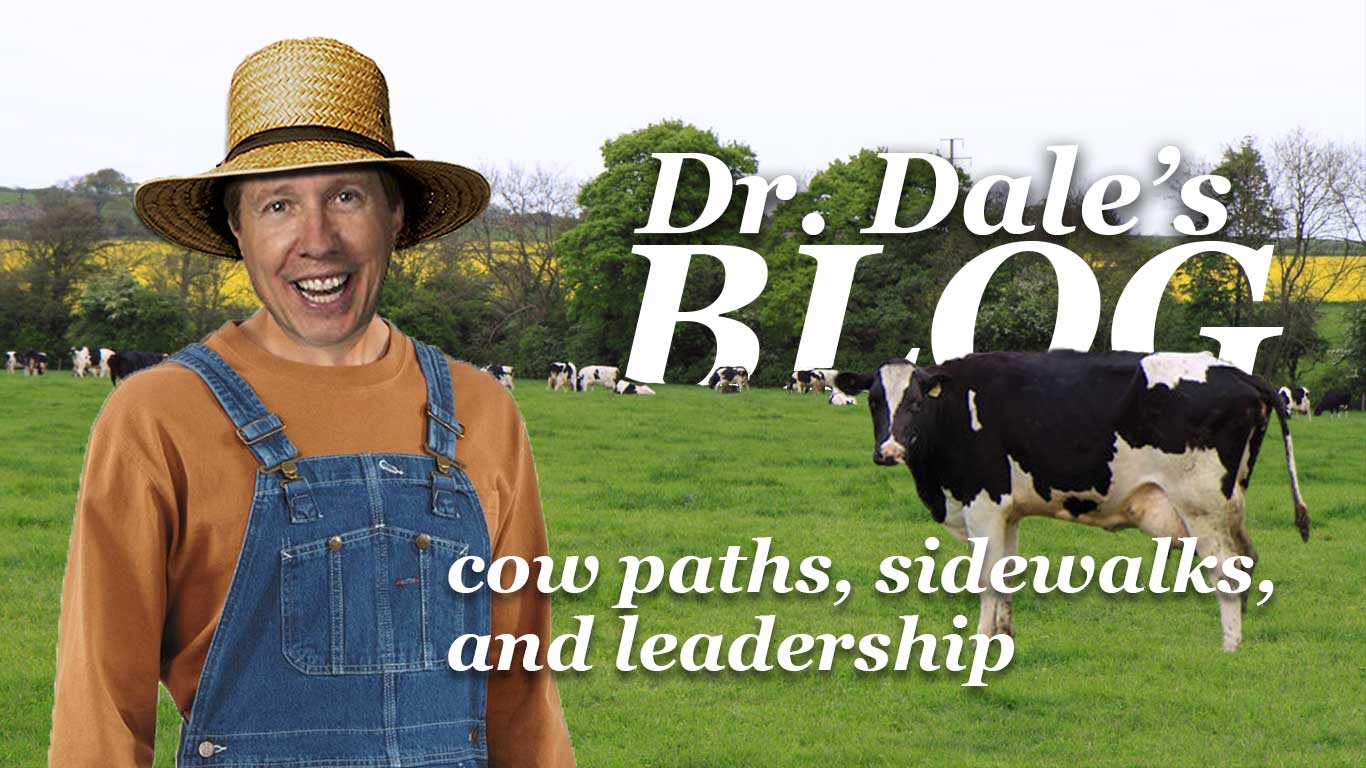empowerment, leadership, responsibility
Cow Paths, Sidewalks, and Leadership
Growing up in East Tennessee, I had the advantage or disadvantage—depending on your point of view—of spending a lot of my time playing on and around the farm. (The disadvantage comes in if you don’t watch where you are walking!) We leased some acreage next to our farm for our dairy and beef cows. One day, while walking with my grandfather (I called him Boss. Come to think of it, everybody called him Boss), I asked him where all the paths came from that weaved throughout the field. He said,
“Well, those are cow paths!”
“Did we make them so the cows would know where to go?” (Ok, before you start thinking I was slow, I was six years old).
“No, the cows just follow each other around and their hooves make those trails.”
The funny thing about those trails is that I walked them, too. Just seemed like the right thing to do; the path was there, and I was going that way. It also kept the cockle burrs and beggar lice off my blue jeans. (If you don’t know what those are, you will just have to google it). I never gave it much thought at the time, but those cow paths became my paths of least resistance. Sometimes our leadership styles tend to take us down paths of least resistance instead of cutting new trails! We settle or we get pulled into a sacred cow path. You know, the old “This is the way we have always done it” cow path. But every now and then, it is healthy for leaders to tie into where the organization needs to go so that they can build more permanent pathways of success.
One of my favorite stories is about a college president who was in the process of building a new campus. All of the buildings were being built, and at every planning meeting, the ground architects would ask about the sidewalks. Every time the subject came up, the president would defer the topic to a future meeting. This went on for months. The campus was nearing completion and the president was getting pressured almost weekly. “Students will be here soon… Where do you want the sidewalks?” Undaunted, the president would put them off! Finally, the students arrived and they were nearing the end of the first semester when the President called the grounds architect and the contractor to his office. Pointing out the window to the many student made cow paths he said, “That’s where the sidewalks go.” He knew from experience that putting paths where he wanted them would not meet the needs of the students and his beautiful lawns would be circumvented with unsightly shortcuts. Leaders need to lead. This is not negotiable, but they need to listen and respond to subtle directions that the organization needs to go. Here are ten strategies that might help you find your path:
1. Leadership must inspire change. Leaders should respect culture while looking for new paths.
A leader must set direction and inspire people to follow him/her. The process of transition requires great change. This is where a strong directional policy comes in. It’s the leaders job to oversee the work needed to implement the necessary changes and realize the possibility of organizational transformation.
2. Leadership requires vision & path selection.
A leader needs to envision what the business is to become. A great vision must have group buy-in to do whatever it takes to achieve the goals conceived by the path setter.
3. Leadership requires imagination to transfer the path from where it is to where it needs to be.
Great leaders can cultivate their imagination to inform their vision. It helps them to “see” what can be. It is this vision and drive that allows their teams to do the specific work necessary to accomplish what has been expressed.
4. Leadership requires abstract thinking–transferring cow paths to sidewalks of opportunity.
By definition, abstract thinking enables a person to make connections among and see patterns within seemingly unrelated information. The ability to think abstractly comes in very handy when reimagining what an organization can become. Those involved in course adjusting must be able to work with and analyze concrete data in order to ensure optimal results.
5. Leadership requires the ability to articulate as well as interpret.
Good leaders can describe their vision in vivid detail, so as to engage and inspire their organization to pursue it. To see the destination, leadership trails must interpret that stated vision and recast (redirect?) it in terms that their teams can understand and embrace.
6. Leadership requires an aptitude to sell and a guide’s ability to teach.
Leaders must sell their vision to their organization and its stakeholders. They must convince all concerned parties that what is envisioned is achievable and provides greater value than what is created by the business today–to teach their teams what must be learned and adapted to attain the stated vision of the path that should be explored.
7. Leadership requires understanding of the external environment, while understanding how work gets done inside the organization.
A leader must understand the business environment in which the enterprise operates, so as to better anticipate opportunities and evade misfortune, while mapping out how to get things done using the resources available to the business.
8. Leadership requires risk-taking mixed with self-discipline.
A leader will take educated risks when setting a strategic direction for a business. Leaders must have the self-discipline to stick to the plan so that the strategic direction will ensure that the strategy comes together as planned.
9. Leadership requires confidence in the face of uncertainty. Every path is a journey to the unknown.
Leaders lives are filled with uncertainty. They’re setting a course for their organization in uncharted territory. Once the course is set, it takes explorers who are duty-bound to follow the stated direction and commit to delivering the results expected.
10. Leadership is accountable to the entire organization, ensuring that team members never get sidetracked.
Finally, leaders must consider the impact of their decisions on the whole organization. A misstep can bring an entire business to its knees. It’s a huge responsibility. Accountability makes them responsible for their teams. They must ensure that their teams are prepared to deliver and that each member is equipped to do what is required for success.
The best leaders lead and let their team explore new paths. Your organization needs people with skills and aptitudes to secure enduring success. Take the time to understand the complexity of turning cow paths to sidewalks so you can build an organization that leverages each to the fullest. (Just watch where you step!)




I heard a similar story when my daughter attended Samford University in Birmingham Alabama, Great School! The sidewalks were everywhere!